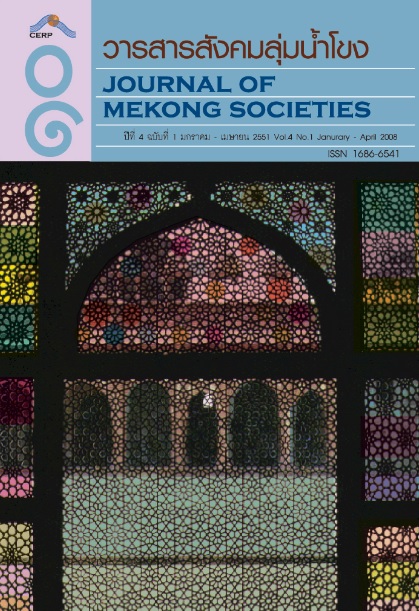The Dynamics in the Relationship of Thai-Lao Border in Globalization
Main Article Content
Abstract
The research objective is to analyze the dynamics of the relationship between Thai and Lao communities across the Mekong River border at Nakorn Phanom Province of Northeast Thailand and Khammuan Province of Laos. This area of study is the so called “Thai-Lao communities.” The study focuses on the Thai government policies and globalization that affect social change and relationships between the two relative communities. The researcher found, in modern days, although the communities are clearly separated politically into two different countries, the Thai-Lao communities still remain the traditional relative relationship across the border. They occasionally share their ethnic roots, customs, and history of Lao tradition. In some circumstances, however, the Thai policies and the international law between the two countries have affected the relationship across the border of the two relative communities. Recently, because of the impact of globalization, the Thai government created a policy of economic development in the area along the border of Thailand and Laos. The Thai-Lao communities took this chance from the government support policy to create an area called Jud Ponpron: “compromised point” and “Thai-Lao border market,” an officially economical exchanged point. In this area, the Thai-Lao governments officially control people traveling in and out across the border, and control merchandise, especially in a market day. At the same time, the governments allow the communities to practice their social norm and custom on non-market days. The Jud Ponpron gives back an opportunity to continue relationships between the two communities under the government policy on international relation and tourism. The communities take this opportunity to organize festivals such as Songkran, “New Year Celebration.” Asking for permission from the government through the Jud Ponpron to organize the festival or other kinds of community activities basically is done by the personal relationship of community leaders, communities as a whole, and officers both Thai and Lao. All are based on relationships among relatives, brother/sisterhoods, and related families. In brief, the relationship between the two communities across the border is various. The interaction depends on situations and the benefit between the two communities as the main purpose. The border, therefore, is area of “unclearness”-“dynamics,” impacted by government powers, communalisms, and the World situation.


